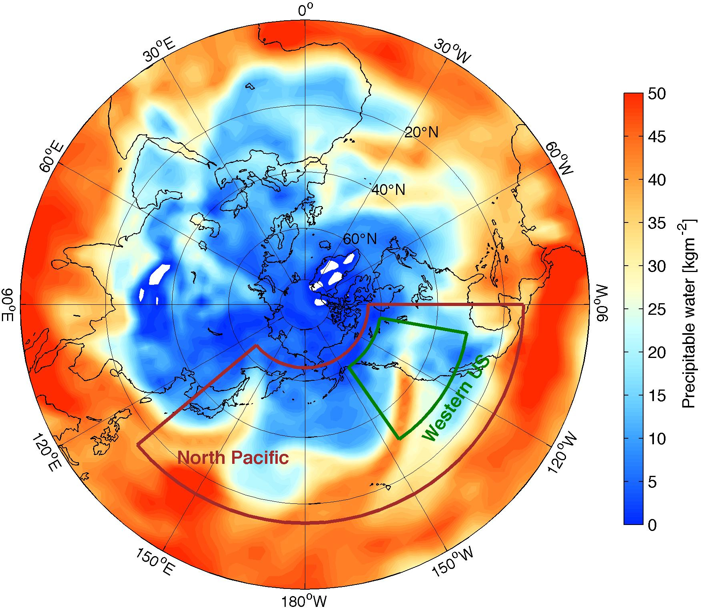NSF EaSM-3: Quantifying Predictability Limits, Uncertainties, Mechanisms, and Regional Impacts of Pacific Decadal Climate Variability (2014-2019)
Climate in the Pacific sector is well known to vary on decadal timescales, but the mechanisms that control these long-term climate variations are still unclear. If the mechanisms can be better understood, then the uncertainties associated with making climate predictions on these timescales can be assessed more accurately. Decadal variability of Pacific climate is of particular interest in the U.S. due to its downstream influence over the western U.S. and its direct influence on climate in Alaska. This leads to the primary focus of our proposal: Overarching Question: What are the predictability limits, mechanisms, and regional impacts for decadal modes of the Pacific climate system?
Intellectual Merit: There is clearly a large gap in our understanding of what controls Pacific decadal climate variability, what limits the predictability of the flows, and what practical skill might be useful in regional impacts on land and in the ocean. Given the availability of a major new climate model, the Community Earth System Model (CESM), a coordinated research effort is needed to better understand basic physical dynamics of Pacific decadal variability and assess the skill of Pacific decadal predictability, along with its uncertainties and practical value. We propose a wide-ranging, coordinated research effort to address key issues of Pacific decadal climate predictability, driving mechanisms, and regional impacts. The proposed work brings together scientists skilled with developing decadal climate diagnostics, making both statistical and dynamical predictions, and executing regional coupled climate downscaling and regional high-resolution ocean modeling to work together to address a suite of important issues in a multi-faceted research program involving senior scientists, early career scientists, post-docs, and graduate students. The research focuses on CESM, with its vast repository of archived runs supplemented with targeted predictability experiments. The analysis focuses on using sophisticated statistical models (Linear Inverse Models) to identify statistical relations among variables, diagnose physical processes, and isolate potentially predictable components of the flows. It also involves using regional coupled atmosphere-ocean, along with uncoupled ocean and atmosphere models, to enhance the understanding of regional response and its potential for practical use in forecasting.
Broader Impacts: The results will be important in assessing how long-term changes in the environment drive changes in economically important variables such as rainfall, soil moisture, snowfall, temperatures, as well as oceanic temperatures, currents and sea levels, which impacts fisheries, agriculture, and coastal infrastructure along the U.S. West Coast and Asian Marginal Seas. We expect that our techniques will be transferable to other global sectors that also exhibit decadal variability. The team will mentor graduate students and post-docs, whose educational experiences will include cross-disciplinary exposure to ocean science, atmospheric science, and societal impacts that will be unique in this context. We also will continue our various efforts of community outreach by giving lectures and educational presentations in public forums, mentoring K-12 students, educating grass-roots climate action organizations, informing the media, and posting our research results on web pages.
Project Webpage: http://easm3-scripps.rhcloud.com
Art Miller, Scripps Institution of Oceanography
Emanuelle Di Lorenzo, Giorgia Institute of Technology
Yu-heng Tseng, National Center for Atmospheric Research
Hyodae Seo, Woods Hole Oceanographic Institution
Duration: 2014-2019
Funded by National Science Foundation
Publications
Seo, H., Distinct influence of air-sea interactions mediated by mesoscale sea surface temperature and surface current in the Arabian Sea. J. Climate, Accepted.
Parfitt, R., A. Czaja, and H. Seo, 2017: A simple diagnostic for the detection of atmospheric fronts, Geophys. Res. Lett., 44, 4351–4358, doi:10.1002/2017GL073662.
Seo, H., A. J. Miller, and J. R. Norris, 2016: Eddy-wind interaction in the California Current System: dynamics and impacts, J. Phys. Oceanogr., 46, 439-459, doi: http://dx.doi.org/10.1175/JPO-D-15-0086.1.
Seo, H., A. C. Subramanian, A. J. Miller, and N. R. Cavanaugh, 2014: Coupled impacts of the diurnal cycle of sea surface temperature on the Madden-Julian Oscillation. J. Climate, 27, 8422-8443 , doi: http://dx.doi.org/10.1175/JCLI-D-14-00141.1.
